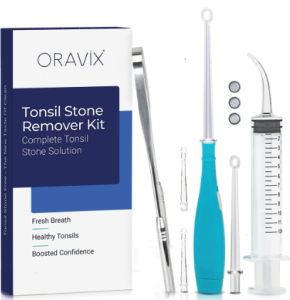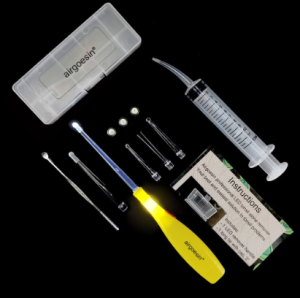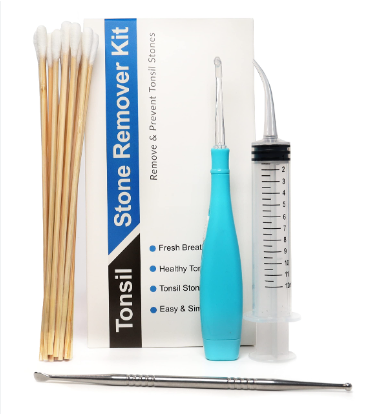Tonsil Stone Removal Tool
Tonsil stones, also known as tonsilloliths, are small, hard masses that can develop in the crevices of the tonsils. They are often a source of discomfort, bad breath, and even throat pain. If you suffer from tonsil stones, you’re not alone, as they affect many people worldwide. Fortunately, there are various methods to remove tonsil stones, and one of the most effective ways is by using the right tonsil stone removal tool. In this comprehensive guide, we will explore the best tonsil stone removal tools available, their features, and how to choose the one that suits you best.
Understanding Tonsil Stones
Before diving into the specifics of tonsil stone removal tools, it’s crucial to understand what tonsil stones are and why they form. Tonsil stones are typically formed when food particles, dead cells, and bacteria get trapped in the tonsil crevices, creating a calcified mass. These stones can vary in size, from small pebbles to larger, more bothersome masses. Common symptoms associated with tonsil stones include:

Bad breath (halitosis).
Sore throat or discomfort.
Difficulty swallowing.
Persistent cough.
Metallic taste in the mouth.
Tonsil stones can be a persistent problem for some individuals, leading to the need for effective removal methods.
The Importance of Choosing the Right Tool
Tonsil stones can be uncomfortable and embarrassing, so finding the right removal tool is crucial. Using the wrong tool or improper techniques can potentially lead to injury, infection, or further complications. Therefore, selecting the best tonsil stone removal tool is essential for a safe and effective solution.
Best Tonsil Stone Removal Tools
Tonsil Stone Removal Kit: These kits typically include various tools like long-handled picks, curved tips, and LED lights to help you locate and remove tonsil stones with precision. The advantage of a kit is that it provides multiple options for different tonsil stone sizes and locations.
Oral Irrigators (Water Flossers): Oral irrigators are effective tools for dislodging and removing tonsil stones with a gentle stream of water. They are less invasive than physical tools and can be used regularly for preventive care.
Tongue Scrapers: While not specifically designed for tonsil stone removal, tongue scrapers can help in dislodging smaller tonsil stones and improving oral hygiene.
Cotton Swabs or Q-Tips: In some cases, a simple cotton swab can be used to gently push or remove smaller tonsil stones. This method requires caution to avoid pushing the stone deeper into the tonsil crevice.

Soft-Tip Oral Suction Devices: These devices are designed to suck out tonsil stones using gentle suction. They are non-invasive and suitable for people who prefer a less hands-on approach.
Electric Tonsil Stone Removers: These specialized devices are designed specifically for removing tonsil stones. They often come with various attachments and settings for precise removal.
Choosing the Right Tonsil Stone Removal Tool
Selecting the best tonsil stone removal tool for your needs depends on various factors, including the size and location of the tonsil stones, your personal preferences, and your comfort level with using different tools. Here are some key considerations to help you make an informed choice:
Tonsil Stone Size: If you frequently experience larger tonsil stones, a tonsil stone removal kit with different tools may be the most versatile option. For smaller stones, a gentle tool like an oral irrigator or suction device may suffice.
Comfort Level: Consider your comfort and confidence in using the chosen tool. Some people may prefer non-invasive methods like oral irrigators, while others may be comfortable using specialized tonsil stone removal tools.
Frequency: If you often develop tonsil stones, it’s wise to invest in a tool that is easy to clean and maintain, such as an oral irrigator.
Budget: Tonsil stone removal tools come in various price ranges. While it’s essential to choose a tool that suits your budget, prioritize effectiveness and safety over cost.
Reviews and Recommendations: Read reviews and seek recommendations from healthcare professionals or online forums to gauge the effectiveness and safety of a specific tonsil stone removal tool.
Safety: Always prioritize safety when using tonsil stone removal tools. Follow the manufacturer’s instructions carefully and consult a healthcare professional if you have any doubts.
How to Use Tonsil Stone Removal Tools
The proper technique for using tonsil stone removal tools varies depending on the type of tool you choose. Here are some general guidelines for using common tonsil stone removal tools:
Tonsil Stone Removal Kit:
Use the provided LED light to locate the tonsil stones.
Gently insert the tool into the tonsil crevice and apply slight pressure to dislodge the stone.
Be cautious not to push the stone deeper into the tonsil.
Oral Irrigator (Water Flosser):
Set the irrigator to a low or medium pressure setting.
Direct the stream of water towards the tonsil stones, gradually increasing pressure if necessary.
Rinse your mouth thoroughly after removal.
Cotton Swabs or Q-Tips:
Wet the swab or Q-tip with warm water.
Gently press and roll the swab against the tonsil stone to dislodge it.
Dispose of the swab after use.
Electric Tonsil Stone Remover:
Follow the manufacturer’s instructions for the specific device.
Typically, these devices come with attachments for various tonsil stone sizes.
Gently insert the attachment and follow the device’s instructions for removal.
Soft-Tip Oral Suction Device:
Place the soft-tip suction device near the tonsil stone.
Use gentle suction to draw the stone out.
Clean the device after use.
Factors to Consider When Choosing a Tonsil Stone Removal Tool:
Tonsil Stone Size:
Tonsil stones can vary in size from tiny specks to larger, more noticeable masses. The size of the tonsil stones you typically experience should influence your choice of removal tool. For smaller stones, less invasive tools like oral irrigators or soft-tip suction devices may suffice. However, for larger or deeply embedded stones, you may need a tonsil stone removal kit with various specialized tools designed for different sizes.
Comfort and Confidence:
Your comfort level with using a particular tonsil stone removal tool is crucial. Some people may prefer non-invasive methods, like oral irrigators, while others may be comfortable using specialized tonsil stone removal tools that require more direct contact with the tonsils. Choose a tool that you feel confident using to avoid causing injury or discomfort.
Frequency of Tonsil Stones:
If you frequently develop tonsil stones, consider a tool that is easy to clean and maintain, such as an oral irrigator. Frequent use of the tool may require regular cleaning and sanitizing to prevent bacterial buildup.
Budget:
Tonsil stone removal tools come in various price ranges. While it’s essential to stay within your budget, prioritize effectiveness and safety over cost. A slightly higher upfront investment in a quality tool can save you money and discomfort in the long run.
Reviews and Recommendations:
Reading reviews and seeking recommendations from healthcare professionals or online forums can provide valuable insights into the effectiveness and safety of specific tonsil stone removal tools. Real-life experiences from others who have dealt with tonsil stones can help you make an informed decision.
Safety:
Always prioritize safety when choosing and using tonsil stone removal tools. Follow the manufacturer’s instructions carefully and, if in doubt, consult a healthcare professional for guidance. Mishandling tools can lead to injury or complications.
Tool Types:
Familiarize yourself with the various types of tonsil stone removal tools available, including:
Tonsil Stone Removal Kits: These kits often include multiple tools, such as long-handled picks, curved tips, and LED lights, providing versatility for different tonsil stone sizes and locations.
Oral Irrigators (Water Flossers): Effective for dislodging tonsil stones with a gentle stream of water, these are less invasive than physical tools.
Tongue Scrapers: While not specifically designed for tonsil stone removal, tongue scrapers can help with smaller tonsil stones and overall oral hygiene.
Cotton Swabs or Q-Tips: A simple cotton swab can be used for gently pushing or removing smaller tonsil stones, but caution is needed to avoid pushing the stone deeper into the tonsil.
Soft-Tip Oral Suction Devices: These devices use gentle suction to remove tonsil stones and are non-invasive, suitable for those who prefer a hands-off approach.
Electric Tonsil Stone Removers: Specialized devices designed specifically for removing tonsil stones, often with various attachments and settings for precise removal.
Conclusion
Dealing with tonsil stones can be uncomfortable, but choosing the right tonsil stone removal tool can make the process much easier and safer. Consider factors like the size and location of your tonsil stones, your comfort level with the chosen tool, and your budget when selecting the best option for you. Always prioritize safety and follow proper techniques to avoid injury or complications. If you’re unsure about the best tool for your situation, consult a healthcare professional for guidance. With the right tool and technique, you can effectively manage and prevent the recurrence of tonsil stones, leading to improved oral health and overall well-being.
Certainly! Here are five frequently asked questions (FAQs) about the best tonsil stone removal tools:
What is the best tonsil stone removal tool for small tonsil stones?
The best tool for small tonsil stones is typically an oral irrigator (water flosser) or a soft-tip oral suction device. These tools provide gentle and non-invasive ways to dislodge and remove smaller tonsil stones effectively.
Which tonsil stone removal tool is suitable for larger or deeply embedded tonsil stones?
Larger or deeply embedded tonsil stones may require the use of a tonsil stone removal kit. These kits often include a variety of tools with different shapes and sizes, making them versatile for tackling various tonsil stone sizes and locations.
Are there any non-invasive tonsil stone removal tools available?
Yes, several non-invasive tonsil stone removal tools are available. These include oral irrigators, soft-tip suction devices, and electric tonsil stone removers. These tools do not require direct physical contact with the tonsils and are generally more comfortable for users.
How do I clean and maintain my tonsil stone removal tools?
Cleaning and maintaining your tonsil stone removal tools are essential to prevent bacterial buildup. Most tools can be cleaned with warm water and mild soap. Be sure to follow the manufacturer’s instructions for each tool, as some may have specific cleaning recommendations.
Can I use a tonsil stone removal tool as a preventive measure?
Yes, many individuals use tonsil stone removal tools as a preventive measure to reduce the likelihood of tonsil stone formation. Tools like oral irrigators can help flush out debris from the tonsil crevices, reducing the chance of tonsil stone development when used regularly as part of good oral hygiene practices.
Remember that it’s essential to choose the right tonsil stone removal tool based on your specific needs and comfort level. If you have concerns or questions about tonsil stones or their removal, consider consulting a healthcare professional for guidance and recommendations tailored to your situation.
